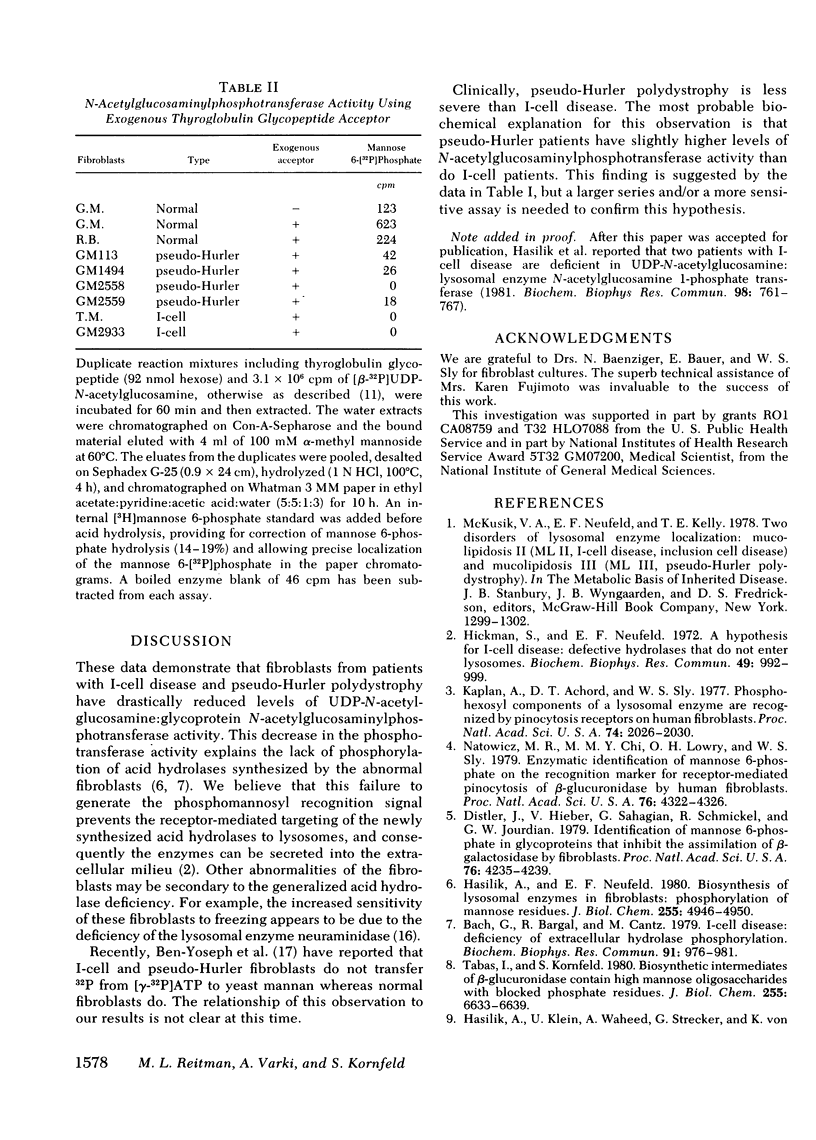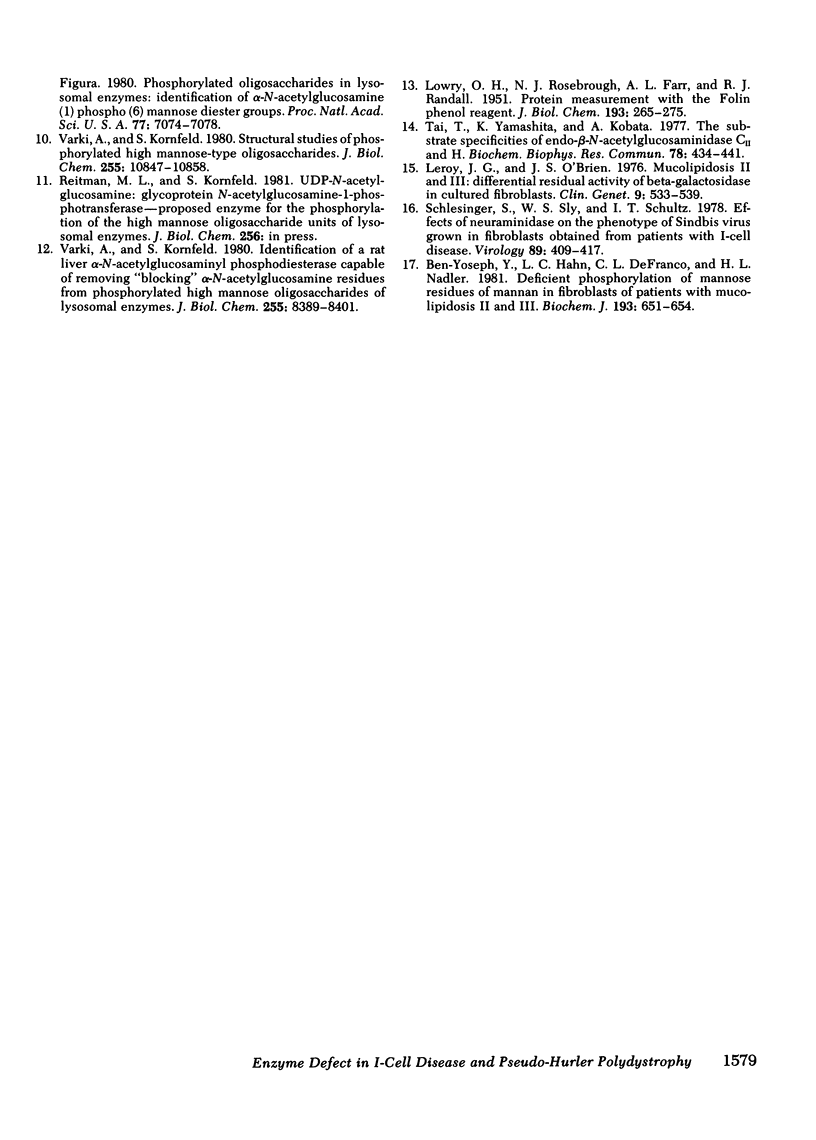Abstract
Newly synthesized acid hydrolases, destined for transport to lysosomes, acquire a phosphomannosyl targeting signal by the transfer of N-acetylglucosamine 1-phosphate from uridine 5'-diphosphate (UDP)-N-acetylglucosamine to a mannose residue of the acid hydrolase followed by removal of the outer, phosphodiester-linked N-acetylglucosamine to expose 6-phosphomannose. This study demonstrates that fibroblasts from patients with the lysosomal enzyme storage diseases, I-cell disease (mucolipidosis II) and pseudo-Hurler polydystrophy (mucolipidosis III), are severely deficient in UDP-N-acetylglucosamine:glycoprotein N-acetylglucosaminylphosphotransferase, the first enzyme of the sequence. The N-acetylglucosaminylphosphotransferase activity (assayed using endogenous acceptors) in cultures from six normal subjects ranged from 0.67 to 1.46 pmol N-acetylglucosamine-1-phosphate transferred/mg protein per h, whereas five pseudo-Hurler polydystrophy and five I-cell disease cultures transferred less than 0.02 pmol/mg protein per h. The activity in five other pseudo-Hurler cultures ranged from 0.02 to 0.27 pmol transferred/mg protein per h. The activity of alpha-N-acetylglucosaminyl phosphodiesterase, the enzyme responsible for phosphomonoester exposure, is normal or elevated in cultured fibroblasts from both I-cell disease and pseudo-Hurler polydystrophy patients. The deficiency of UDP-N-acetylglucosamine:glycoprotein N-acetylglucosaminylphosphotransferase explains the biochemical abnormalities previously observed in I-cell disease and pseudo-Hurler polydystrophy.
Full text
PDF





Selected References
These references are in PubMed. This may not be the complete list of references from this article.
- Bach G., Bargal R., Cantz M. I-cell disease: deficiency of extracellular hydrolase phosphorylation. Biochem Biophys Res Commun. 1979 Dec 14;91(3):976–981. doi: 10.1016/0006-291x(79)91975-2. [DOI] [PubMed] [Google Scholar]
- Ben-Yoseph Y., Hahn L. C., DeFranco C. L., Nadler H. L. Deficient phosphorylation of mannose residues of mannan in fibroblasts of patients with mucolipidoses II and III. Biochem J. 1981 Feb 1;193(2):651–654. doi: 10.1042/bj1930651. [DOI] [PMC free article] [PubMed] [Google Scholar]
- Distler J., Hieber V., Sahagian G., Schmickel R., Jourdian G. W. Identification of mannose 6-phosphate in glycoproteins that inhibit the assimilation of beta-galactosidase by fibroblasts. Proc Natl Acad Sci U S A. 1979 Sep;76(9):4235–4239. doi: 10.1073/pnas.76.9.4235. [DOI] [PMC free article] [PubMed] [Google Scholar]
- Hasilik A., Klein U., Waheed A., Strecker G., von Figura K. Phosphorylated oligosaccharides in lysosomal enzymes: identification of alpha-N-acetylglucosamine(1)phospho(6)mannose diester groups. Proc Natl Acad Sci U S A. 1980 Dec;77(12):7074–7078. doi: 10.1073/pnas.77.12.7074. [DOI] [PMC free article] [PubMed] [Google Scholar]
- Hasilik A., Neufeld E. F. Biosynthesis of lysosomal enzymes in fibroblasts. Phosphorylation of mannose residues. J Biol Chem. 1980 May 25;255(10):4946–4950. [PubMed] [Google Scholar]
- Hickman S., Neufeld E. F. A hypothesis for I-cell disease: defective hydrolases that do not enter lysosomes. Biochem Biophys Res Commun. 1972 Nov 15;49(4):992–999. doi: 10.1016/0006-291x(72)90310-5. [DOI] [PubMed] [Google Scholar]
- Kaplan A., Achord D. T., Sly W. S. Phosphohexosyl components of a lysosomal enzyme are recognized by pinocytosis receptors on human fibroblasts. Proc Natl Acad Sci U S A. 1977 May;74(5):2026–2030. doi: 10.1073/pnas.74.5.2026. [DOI] [PMC free article] [PubMed] [Google Scholar]
- LOWRY O. H., ROSEBROUGH N. J., FARR A. L., RANDALL R. J. Protein measurement with the Folin phenol reagent. J Biol Chem. 1951 Nov;193(1):265–275. [PubMed] [Google Scholar]
- Leroy J. G., O'Brien J. S. Mucolipidosis II and III: different residual activity of beta-galactosidase in cultured fibroblasts. Clin Genet. 1976 May;9(5):533–539. doi: 10.1111/j.1399-0004.1976.tb01608.x. [DOI] [PubMed] [Google Scholar]
- Natowicz M. R., Chi M. M., Lowry O. H., Sly W. S. Enzymatic identification of mannose 6-phosphate on the recognition marker for receptor-mediated pinocytosis of beta-glucuronidase by human fibroblasts. Proc Natl Acad Sci U S A. 1979 Sep;76(9):4322–4326. doi: 10.1073/pnas.76.9.4322. [DOI] [PMC free article] [PubMed] [Google Scholar]
- Schlesinger S., Sly W. S., Schulze I. T. Effects of neuraminidase of the phenotype of sindbis virus grown in fibroblasts obtained from patients with I-cell disease. Virology. 1978 Sep;89(2):409–417. doi: 10.1016/0042-6822(78)90183-6. [DOI] [PubMed] [Google Scholar]
- Tabas I., Kornfeld S. Biosynthetic intermediates of beta-glucuronidase contain high mannose oligosaccharides with blocked phosphate residues. J Biol Chem. 1980 Jul 25;255(14):6633–6639. [PubMed] [Google Scholar]
- Tai T., Yamashita K., Kobata A. The substrate specificities of endo-beta-N-acetylglucosaminidases CII and H. Biochem Biophys Res Commun. 1977 Sep 9;78(1):434–441. doi: 10.1016/0006-291x(77)91273-6. [DOI] [PubMed] [Google Scholar]
- Varki A., Kornfeld S. Identification of a rat liver alpha-N-acetylglucosaminyl phosphodiesterase capable of removing "blocking" alpha-N-acetylglucosamine residues from phosphorylated high mannose oligosaccharides of lysosomal enzymes. J Biol Chem. 1980 Sep 25;255(18):8398–8401. [PubMed] [Google Scholar]
- Varki A., Kornfeld S. Structural studies of phosphorylated high mannose-type oligosaccharides. J Biol Chem. 1980 Nov 25;255(22):10847–10858. [PubMed] [Google Scholar]


